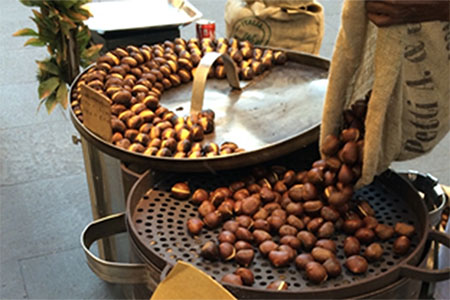Michigan State University researchers are helping keep the holiday season green and fragrant by dedicating their expertise year-round to Michigan’s flourishing Christmas tree and chestnut industries.

Michigan State University researchers are helping keep the holiday season green and fragrant by dedicating their expertise year-round to Michigan’s flourishing Christmas tree and chestnut industries.

MSU’s chestnut research program, launched in the early 1990s, includes a multidisciplinary team of faculty, including Daniel Guyer, a professor of biosystems and agricultural engineering in the College of Engineering and the College of Agriculture and Natural Resources, and Mario Mandujano, a research associate in CANR’s Department of Plant, Soil and Microbial Sciences, who are developing new ways to keep chestnuts growing and flourishing in Michigan.
 Chestnut plants from tissue cultures. Courtesy of Mario Mandujano
Chestnut plants from tissue cultures. Courtesy of Mario Mandujano A chestnut plant start. Courtesy of Mario Mandujano</span>
A chestnut plant start. Courtesy of Mario Mandujano</span> Chestnuts. Courtesy of Emilie Lorditch
Chestnuts. Courtesy of Emilie Lorditch Bowls of chestnuts. Courtesy of Emilie Lorditch
Bowls of chestnuts. Courtesy of Emilie LorditchAnother issue with chestnuts is storing them. They should be treated more like produce than like traditional nuts, such as dry as they are a living respiring commodity. They should be stored between 28 and 30 degrees Fahrenheit, Mandujano said. If you keep chestnuts cold and in an air-tight container to minimize moisture loss, it is possible they can last three to four months.
That means you can enjoy fresh chestnuts well past the holiday season.
 Chestnut picking. Courtesy of Mario Mandujano
Chestnut picking. Courtesy of Mario MandujanoLike chestnuts, Christmas trees also have a long history as a research subject at MSU. Bert Cregg, a professor of horticulture and forestry in CANR, has been conducting Christmas tree research for the past 21 years. Cregg specializes in tree physiology, nutrition and coning. Unlike crops planted and harvested in the same year, Christmas trees are a waiting game that take up to a decade from seed to cutting.
“We help farmers manage their crops, and they can maximize their efficiency by not putting out fertilizer they don’t need,” Cregg said. “Farmers are good stewards and try to be as sustainable and environmentally friendly as possible.”
Coning, or the excess production of cones, on Frasier fir trees is another issue Cregg is working on. “Frasier firs produce a lot of cones at an early age and the growers have to pick them off by hand,” he said. “A 9-foot tree could have up to a thousand cones.”
 Hand picking cones off of Frasier fir trees. Courtesy of Bert Cregg
Hand picking cones off of Frasier fir trees. Courtesy of Bert Cregg Frasier fir tree. Courtesy of Emilie Lorditch
Frasier fir tree. Courtesy of Emilie Lorditch Drone test for Christmas trees in Bert Cregg's research plot. Courtesy of Bert Cregg
Drone test for Christmas trees in Bert Cregg's research plot. Courtesy of Bert Cregg Christmas tree heights map. Courtesy of Robert Goodwin
Christmas tree heights map. Courtesy of Robert Goodwin NDVI image of tree health. Courtesy of Robert Goodwin
NDVI image of tree health. Courtesy of Robert GoodwinApplying vegetative indices to these images, such as NDVI (Normalized Difference Vegetation Index) and others, tree health can be displayed according to an easily interpretable color ramp,” he said. “Typically, dark green represents healthy trees and orange or red represents trees that are less healthy.”
From Christmas trees that are the perfect shade and height to chestnuts that produce the sweetest treat after roasting on the open fire, MSU research means that even during a unique year like this one, there are still some holiday traditions that will remain.
 Roasted chestnuts Image courtesy of Mario Mandujano
Roasted chestnuts Image courtesy of Mario Mandujano
 Frasier fir tree Image courtesy of Emilie Lorditch
Frasier fir tree Image courtesy of Emilie Lorditch